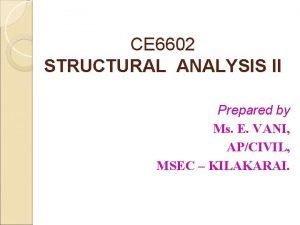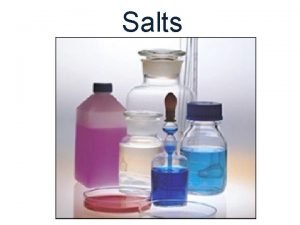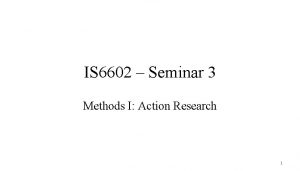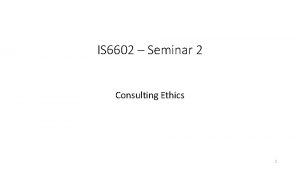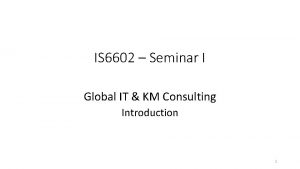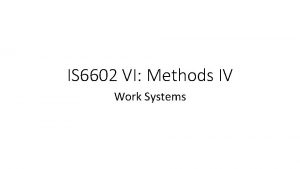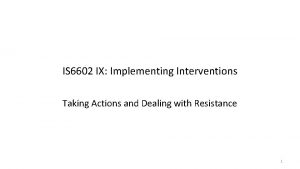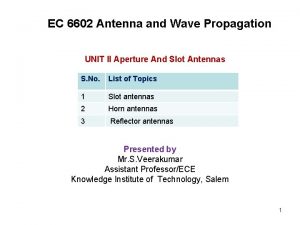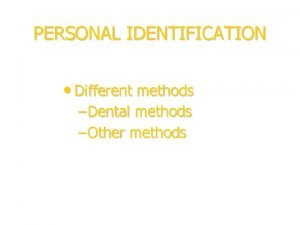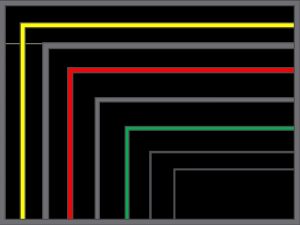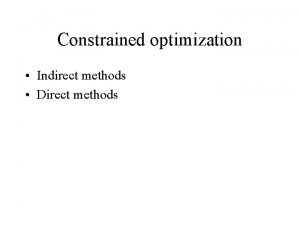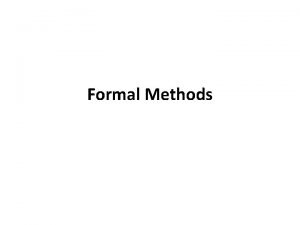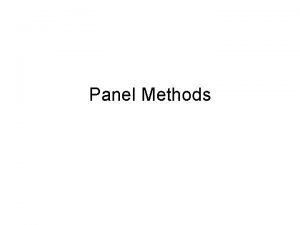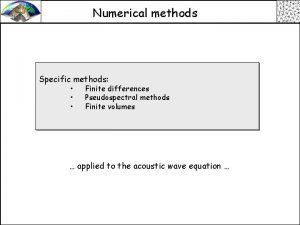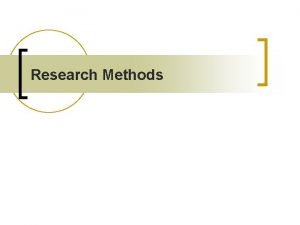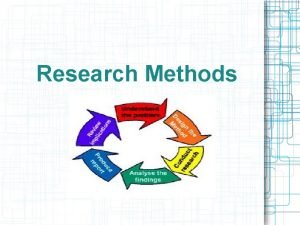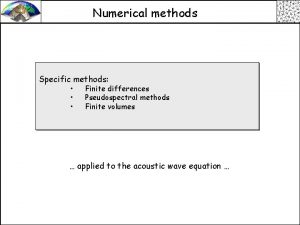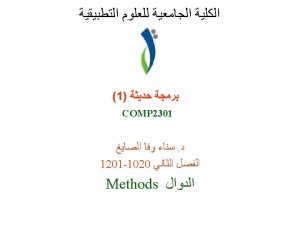IS 6602 Seminar IV Methods II Preparing for


































- Slides: 34

IS 6602 – Seminar IV Methods II: Preparing for Diagnosis 1

Notes for Coursework • I want to clarify that the problem does not need to be an IS or KM problem. – It may be management, HR, logistics, marketing, communication, accounting, etc. Any kind of business related problem • But the proposal that you write needs to have an IS or KM aspect to it. – This should not be too difficult because IS can be applied to most kinds of problem situation. 2

Recap of Action Research • Last week, we looked at how Action Research can be applied in consulting projects • Action Research is explicitly designed to focus on interventions, with consultants diagnosing a situation, proposing actions, intervening and then assessing progress • Action Research is also explicitly collaborative, since the client must be a willing participant in the AR project, actively involved. – Why do you think collaboration is so important? 3

Into the Details • While the AR method provides the broad framework under which consultants can work, AR does not provide all the details of how they should work. • We need to examine the work processes in some detail so as to find out exactly which activities need to be undertaken and how • Today we will start to look at the diagnostic phase, the first of the five phases in the AR cycle 4

Diagnosis • Of all the five phases in the AR cycle, diagnosis is the one that may take the longest to complete • In my own experience, diagnosis can take several months, depending on: The scope of investigation The degree of cooperation of the client The complexity of the problem situation The number of employees to be interviewed The extent of agreement among stakeholders about the nature of the problem itself – The experience of the consultants – – – 5

Diagnosis • Getting the diagnosis right is critical, if any actions based on the diagnosis are to be effective • But getting the diagnosis right is not at all easy • Although a problem situation may appear to be simple, there may be a complex collection of underlying causes that defy easy identification, especially if employees are scared – If different people have radically different opinions, these need to be considered carefully – Why might employees be scared? Of what or who? 6

For Example • You are asked to help a firm with its ERP implementation • The CEO explains that they have multiple disconnected systems and now want to integrate everything – This is reasonable and should lead to process improvements and efficiencies • However, initial reactions from employees are negative and the CEO is afraid that the resistance will be strong • You need to diagnose what’s going on before you can recommend any changes 7

Diagnosis • What do you think might be the causes of the negative reactions? Why might employees resist the new ERP? • How long will you need to uncover all of these causes? • Could some of the causes be not only technical, but also social or political or educational? • Are you only an ERP consultant, or do you need to deal with psychological issues as well? 8

Diagnosis or Education? • When I used AR in a KM consulting project with Eastwei, the CEO asked me to interview all 79 employees!!! • He suggested that my interviewing them would make them think about Knowledge and Sharing – good for their education! • So, I had both an educational and a diagnostic role to play. • The CEO did not only want a simple diagnosis – He also wanted me to prepare the ground for change by enlightening the employees. – Is that the consultant’s job? To be a psychological counsellor? To be an educator? • Does the consultant have to be multi-talented? 9

Cultural Outcomes • The educational function that a consultant may perform can also lead to other benefits • For instance, as a result of involving many employees in an interview process, it is possible not only to educate them but also to create a sense of belonging, a sense of group culture • This is important as a strongly supportive environment can help to ensure later success • When people are involved in the diagnostic process, they are less likely to reject its outcomes. Why? 10

Aspects of Diagnosis • • • Preparation for diagnosis Communication with the project champion Recognising the needs of different stakeholders Identifying gaps and targets Identifying requirements Keeping an open mind at all times 11

Building Trust • Consultants must develop sufficient trust with the organisational project champion • Since you will need to interview many people and observe many work situations, you need to develop that trust – You can’t assume that because you are invited, you are automatically welcome! – You can assume that you can be kicked out at any time! • What can you do (or not do) to help them to trust you? 12

Trust and Confidence • The initial trust will form the bedrock of the consultantclient relationship • On that foundation, you can build a strong relationship and have the confidence to ask for access to the people, places and documents that you need • Confidence breeds confidence – If you are confident and show it, the client will be more confident in you. – How can you show confidence? 13

Confidence and Detection • If you want to deliver a high quality service, then you need a high quality understanding of the organisational context, problem, stakeholders and requirements • Achieving that understanding requires detective skills – Who, What, Where, When, Why, How? ? ? – Which is/are the most important question(s) for a consultant to ask? • With that understanding you may later be able to build a strong case for change 14

Detection of What? • Problems are rarely purely IS or KM • They often cross multiple departments and people • Can you solve the IS/KM problem and ignore everything else? • Or do you need to become an expert in one topic but also a knowledgeable consultant in many others? • What do you think the client wants? • What is your responsibility? 15

For Example • You are an e-Business consultant helping an American retailer to set up its new online business venture in China • The retailer wants to import and sell high quality, tasty, dried beef (from American cows) to Chinese consumers. • The American CEO has contracted you to come up with a solution, so as to ensure that the venture is successful • What kinds of issues (IS, KM, others) are going to be relevant? – The issues are things that you will need to ask questions about. 16

Alternatively • You are a Knowledge consultant helping a Hong Kong executive-search firm to mitigate the negative consequences associated with brain drain – Whenever senior employees leave the company, they take all their knowledge and contacts with them – Newly hired junior employees don’t have that knowledge • There is a KM system in the firm, but no one uses it. Instead, each person keeps all their own records, files, information in a private database. • What kind of questions do you need to ask as you undertake the diagnosis? Who will you talk to? 17

Or… • Your good friend, the warehouse manager, is puzzled why it is so difficult to find items on shelves in the warehouse. • He has an inventory management system (IMS), but it is always wrong – The data in the system does not match the real situation • Employees are friendly and cooperative, but none of them trust the IMS, so they create their own Excel-based private systems. • How are you going to investigate and diagnose, so as to help your friend? 18

Gaps and Goals • A significant aspect of needs analysis is the identification of gaps – Where is the organisation now? – Where does the organisation want to be later? • This requires – A detailed evaluation of the now – A goal (the ideal future) – A way of measuring progress 19

Needs Change • Undertaking a needs analysis requires – the involvement of many people and processes – an assessment of current systems and resources – a broad appreciation for what is possible • It may take several iterations – Needs can change over time – The problem itself may shift – There is an infinite variety of circumstances 20

Whose Needs? • If a consultant only listens to senior management, then this will be a very limited view of what is needed • So, you need to take care to ensure that all the different voices are heard – The problem as identified by the CIO/CEO may be totally different to the situation as experienced by the front line employees – Consultants should remain impartial and open minded – This is why it is important that the consultant’s diagnosis is independent of whatever the company tells you. 21

For Example • When I consulted in Ruder Finn Asia, the CEO told me that he wanted to centralise all knowledge sharing arrangements on a single platform, so that all employees could benefit • We proposed a solution based on Microsoft Share Point • Employees initially accepted this in principle, but later refused to use the new system 22

Explanation The employees saw no value in a single unified platform It did not make their lives easier – in fact, the opposite It did not help them to be more efficient Instead, it obstructed their communications For them, integration and central control were not significant goals • What mistake did I make? • Why did the employees change their minds? • • • 23

A Balanced Diagnosis • So the consultant needs to talk to a wide range of people – And ideally aim to satisfy all their needs • Different people have not only different needs, but also different skill and education levels – Some may love change, others will resist it – Some may see the opportunity to develop new skills, or build power structures, whereas others see a threat to their stable and peaceful lives 24

A Shared Commitment • The principle of collaboration requires that all organisational stakeholders collaborate • If the consultant recommends a process that depends on employees being deeply involved in the change process… • … then I hope that the employees are willing to be deeply involved – and to change! 25

For Example • When a local HK SME tried to implement a new ERP (Oracle), the consultant encountered fierce resistance from the mostly older (50 s, 60 s) employees • They refused to abandon their old spreadsheets or cooperate in any way • The implementation failed and the firm later went bankrupt! • Should we be surprised? What could the consultant have done differently? Or was it too late for change? 26

Motives and Comfort • • • What are the client’s motives? Do you feel comfortable with these? Do you want to be associated with this change process? How would you feel if you were one of the employees? What are your values? – Remember the principles of beneficence and nonmaleficence • Can you imagine a situation where you would NOT want to be a consultant? 27

For Example • Imagine that you are asked to prepare a training course for employees to help them use social media more effectively when dealing with customers • When you talk to the CEO, you learn that some customers have complained that employees are rude, inconsistent, casual and unprofessional in their behaviour • Superficially, this seems to be a reasonable problem 28

Continued • You ask to speak with some of these employees AND customers so as to understand the situation from their perspectives BEFORE you design the workshop • The CEO refuses to allow this, so the only evidence you have for the problem is the CEO’s point of view. • Is this enough? Do you believe the first person who talks to you or consider many voices? 29

Continued • If you cannot talk to a representative selection of stakeholders (including employees and customers) then it is very hard to know if your workshop design is appropriate – Maybe the CEO is wrong – You may end up looking very foolish – And failing to solve any problems • So you need to decide quite quickly if you want to take on this job or not 30

Barriers to Needs Assessment • Interviewing employees, perhaps lots of them, not only takes the consultant’s time, but also takes those employees away from their work • This may be seen as too high a cost by the organisation, which seeks to limit the numbers interviewed • Consultants may have to take the role of persuading management of the importance of interviewing people 31

Arguments for Interviews • Interviewing lots of people not only ensures that voices are heard representatively, but also provides the opportunity to confirm the magnitude of a problem – Perhaps it is more or less serious than previously thought – Perhaps employees already try to work around the problem – Perhaps employees already created a workable solution – you need to know because your solution has to work with their solution. Or can you base yours on theirs? • If the problem is better understood, then it is more likely that a good solution can be developed – A good solution is one that solves problems AND does not create new problems! 32

Diagnostic Reflections • Consultants need to bear in mind that they cannot solve all the problems – Problems in organisations cover a range of topics. – Many of those problem areas are quite suitable for an IT or KM solution because IT/KM are embedded in organisational processes. – So, when we talk to employees, we need to keep IT and KM in mind – Naturally, the employees will talk about their experience of problems and this may be somewhat outside our experience. – But we have to listen to whatever they say, even the bits we don’t quite understand, and also encourage them to think about IS/KM aspects as well. • Ultimately, we want to be in the position where we can propose a way forwards that blends the IT/KM aspects into the solution. 33

Conclusions • Consultants (like doctors) need to distinguish symptoms from the underlying causes • All voices are legitimate, but each is biased, including the consultant – The consultant has to work out what happened – The consultant needs to work as a detective, investigating the situation, probing for details, exploring, questioning, doubting – Who did what, where, when, why and how? – If the client is willing to cooperate and collaborate then the consultant’s life is much easier • An accurate diagnosis is critical to the eventual success of the project 34
 Ec 6602
Ec 6602 Flexibility method
Flexibility method Friis transmission formula
Friis transmission formula Nascent soap emulsion
Nascent soap emulsion Double replacement reaction
Double replacement reaction Direct wax pattern
Direct wax pattern Standardavvikelse
Standardavvikelse Tack för att ni har lyssnat
Tack för att ni har lyssnat Var finns arvsanlagen
Var finns arvsanlagen Tidbok
Tidbok Rutin för avvikelsehantering
Rutin för avvikelsehantering Myndigheten för delaktighet
Myndigheten för delaktighet Presentera för publik crossboss
Presentera för publik crossboss Kontinuitetshantering i praktiken
Kontinuitetshantering i praktiken Debattartikel struktur
Debattartikel struktur Kung som dog 1611
Kung som dog 1611 Tobinskatten för och nackdelar
Tobinskatten för och nackdelar Referat mall
Referat mall Fimbrietratt
Fimbrietratt Varför kallas perioden 1918-1939 för mellankrigstiden
Varför kallas perioden 1918-1939 för mellankrigstiden Byggprocessen steg för steg
Byggprocessen steg för steg Karttecken tät skog
Karttecken tät skog Formel för lufttryck
Formel för lufttryck Rbk-mätning
Rbk-mätning Densitet vatten
Densitet vatten Elektronik för barn
Elektronik för barn Borra hål för knoppar
Borra hål för knoppar Tack för att ni har lyssnat
Tack för att ni har lyssnat Smärtskolan kunskap för livet
Smärtskolan kunskap för livet Bris för vuxna
Bris för vuxna Anatomi organ reproduksi
Anatomi organ reproduksi Trög för kemist
Trög för kemist Argument för teckenspråk som minoritetsspråk
Argument för teckenspråk som minoritetsspråk Typiska novell drag
Typiska novell drag Enheter för massa
Enheter för massa

